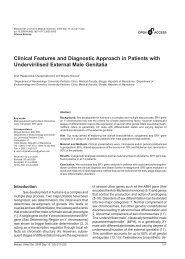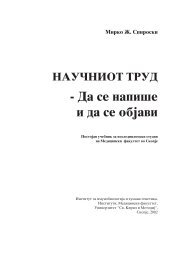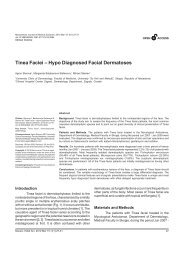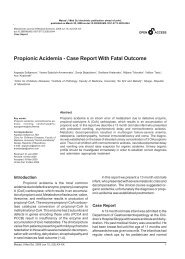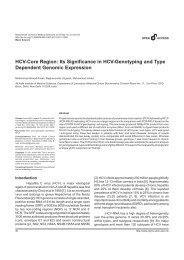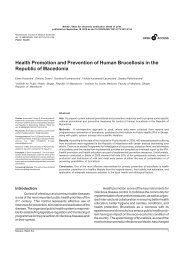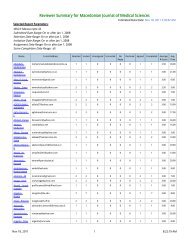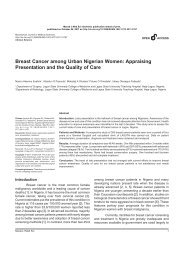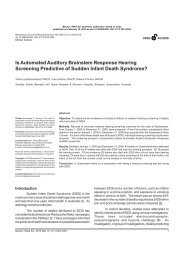Full-Text PDF - Macedonian Journal of Medical Sciences
Full-Text PDF - Macedonian Journal of Medical Sciences
Full-Text PDF - Macedonian Journal of Medical Sciences
You also want an ePaper? Increase the reach of your titles
YUMPU automatically turns print PDFs into web optimized ePapers that Google loves.
which infants are at risk <strong>of</strong> dying <strong>of</strong> SIDS has not been<br />
established [4].<br />
A recent report by Rubens et al., 2008 suggested<br />
an association between right sided unilateral hearing<br />
deficits as detected by newborn transient evoked<br />
otoacoustic emissions and the risk <strong>of</strong> SIDS [5]. Sininger<br />
et al., 2006 and Berninger, 2007 have previously reported<br />
larger amplitude waves on the right side on auditory<br />
brainstem response (ABR) testing in normal neonates<br />
[6,7]. An increased venous pressure effect on the right<br />
side causing disruption to the inner ear hair cells is a<br />
proposed mechanism for the unilateral difference [5].<br />
Stimulation <strong>of</strong> the vestibular system is known to cause a<br />
change in the respiratory pattern [8,9]. Vestibular stimulation<br />
can re-establish respiratory effort after apnoea [8-10]. An<br />
abnormality in respiratory control is a proposed mechanism<br />
for SIDS [5]. Inner ear insults can disrupt cochlear and<br />
vestibular function and it is possible that such an injury<br />
may occur in the perinatal period [5].<br />
The transient evoked otoacoustic emission<br />
technique described by Rubens et al [5] uses a small<br />
probe placed in the baby’s ear and the administration <strong>of</strong> a<br />
click stimulus at four frequencies in each ear (1500, 2000,<br />
3000 & 4000 decibels [dB]). A signal/noise ratio (SNR) is<br />
generated for each ear at each frequency. The SNR is the<br />
difference between the hearing measurement in decibels<br />
and the level <strong>of</strong> background noise. To have a pass then the<br />
following conditions need to be met:<br />
1. SNR ≥ 4dB at 2,3 & 4 kilohertz;<br />
2. a click stimulus level between 74 dB and 86 dB;<br />
3. ≥ 50 sweeps <strong>of</strong> stimulus delivery in which the<br />
detected noise floor falls below the s<strong>of</strong>tware’s<br />
predetermined acceptance/rejection level.<br />
The Royal Brisbane and Women’s Hospital has<br />
undertaken a universal newborn screening program<br />
(Healthy Hearing) since October 2004. This has gradually<br />
been established in other Queensland centres, and since<br />
December 2006 has been available to all birthing facilities<br />
in the state.<br />
Australia is a wealthy country, with generally high<br />
standards <strong>of</strong> medical care readily available. Its system <strong>of</strong><br />
government has evolved from liberal democratic tradition,<br />
with influence from British and North American models<br />
[11]. Based on per capita gross domestic product, Australia<br />
ranks among the top twenty nations in the world [11]. Life<br />
expectancy for males and females is seventy-nine and<br />
eighty-four years respectively [11]. Queensland’s<br />
Maced J Med Sci. 2010 Mar 15; 3(1):32-36.<br />
Brinsmead TL. Sudden Infant Death Syndrome<br />
population, which represents 21% <strong>of</strong> Australia’s total, is<br />
estimated at 4.47 million [12]. 92% <strong>of</strong> the Australian<br />
population is Caucasian, Asians consistute 7%, and less<br />
the 1% is made up <strong>of</strong> Aboriginals (indigenous Australians)<br />
and other ethnic groups [13]. It is well known that health<br />
outcomes are consistently poorer in the indigenous<br />
population. Although Australia is an arid environment [14],<br />
88.6% <strong>of</strong> the population reside in urban areas [11], which<br />
are typically clustered around the more moderate, coastal<br />
regions.<br />
The aim <strong>of</strong> this study was to determine the<br />
incidence <strong>of</strong> unilateral deficits on newborn hearing screening<br />
in babies who have died <strong>of</strong> SIDS.<br />
Methods<br />
Records <strong>of</strong> universal newborn hearing screening<br />
outcomes for the state <strong>of</strong> Queensland, from October 2004<br />
to December 2006 inclusive, were accessed. A list <strong>of</strong> all<br />
sudden, unexplained infant deaths in the period January 1,<br />
2005 to December 31, 2006 inclusive was acquired from<br />
the Queensland State Coroner. For each child whose<br />
death was attributed to SIDS, individual hearing screening<br />
results were reviewed if available. To improve the likelihood<br />
<strong>of</strong> identifying hearing screening results on each baby,<br />
searches were conducted under the child’s surname at<br />
the time <strong>of</strong> death, and maternal surname at the time <strong>of</strong><br />
birth.<br />
Hearing screening requires detecting the presence<br />
or absence <strong>of</strong> a response at a preset signal intensity level<br />
for the purpose <strong>of</strong> identifying which infants need further<br />
evaluation. The screening process in Queensland utilises<br />
Automated Auditory Brainstem Response (AABR)<br />
equipment. The goal <strong>of</strong> AABR is to detect the presence or<br />
absence <strong>of</strong> a signal, not estimate its characteristics [5].<br />
The screening equipment used by Queensland Health is<br />
the Natus ALGO 3® and the ALGO 3i® (Natus, San<br />
Carlo). One <strong>of</strong> the unique features <strong>of</strong> the ALGO® response<br />
detection method is the use <strong>of</strong> a binary signal detector.<br />
The equipment automatically records whether the baby<br />
has passed the screen (‘pass result’) or whether a referral<br />
for further screening (‘refer result’) is required. If a baby<br />
receives a ‘refer result’ on either or both ears a second<br />
screen <strong>of</strong> both ears is conducted at a later time to confirm<br />
the result. A ‘refer result’ does not necessarily mean that<br />
the baby has a hearing loss. Some common reasons for<br />
needing a second screen are: the baby was unsettled at<br />
the time <strong>of</strong> the first screen; there was background noise<br />
when the test was carried out and/or; the baby had fluid or<br />
a temporary blockage in their ear after birth. If the baby<br />
33



